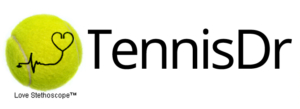Racket Sports Biomechanics: Brain Function, Eye Skills, and Table Tennis
How closely related are table tennis skills to tennis? Can ping pong help my vision skills, reactions, and balance? Can table tennis help improve brain function or help me read better? These kinds of questions about the impact of table tennis on brain function and motor skills are starting to capture the attention of researchers. The author has some unique credentials to help bring the reader up to speed on these questions by first looking at the unique qualities of table tennis, then their application to brain function.
First, ping pong can definitely help anyone learn tennis and other racket sports. One rough measure of mastering a tennis movement is the creation of spin. With the exception of flat ground strokes, elite players prefer extreme spin to add control and can make the ball rotate several thousand times a minute. In order to do that the racket must pass steeply through contact. The more steep the path, the more spin is imparted, but as the path becomes faster/steeper it becomes less tolerant for error. That’s where better skill comes in!
Since ping pong helps teach players spin (its elite players also want fast rotation for control), that makes table tennis motions great preparation for learning spin for tennis. Further, these sports also use subtle forms of side spin, another rare stepping stone between these two sports. But table tennis can go much farther than good preparation for tennis.
The connection between the brain and visual/motor skills required to play competitive table tennis are useful to practically ANY other sport and even reading as noted below. Many athletic abilities are improved such as eye muscle tracking, recognition, decision making, response time, muscle activation, and rhythmic muscular response are all ramped up.
Eye muscle tracking skills may be the most unique set of physiological skills enhanced by table tennis. Most sports emphasize distances for eye teamwork beyond 15 feet, also called “Optical Infinity”. Within 15 feet the eyes work much harder to track, diverge, and converge on objects.
To prove this, stay focused on your finger at arms length as you gradually move it toward your nose. See how it becomes more difficult to keep focused until the eyes “give up” and create a double image? Most of ping pong’s tracking skills occur within or near this convergence/divergence range for the human visual system. At the same time, the basic manual task itself is relatively easy.
According to Dr. Gary Polan, a pioneer in the field of Vision Training (VT)/Sports Vision Training (SVT), eye hand skills like ping pong help stimulate the visual/motor system in similar ways to the skills needed for reading performance. Every day at his office he helps patients improve their reading challenges by exercising the visual cortex, the interocular muscles which control the lenses of the eye, and the extraocular muscles which control eye teamwork. Dr. Polan says that EVERY reader and athlete, even elite athletes, can improve performance with VT/SVT. Better eye performance makes better readers AND better athletes because–ALL eye skills are learned!
The attribute of “ease of use”, the usability of table tennis, has other huge advantages. Table tennis allows almost every first time user, from kids to seniors, to quickly feel competent. After that, its easier than most other sports to ramp up overall physical performance in the first few sessions, without coaching. This “ease of use” attribute has captured the attention of scientists too.
Some researchers are interested in ping pong’s influence on the brain, its ability to adapt, improve function, and ward off chronic disease. Dr. Mehmet Oz calls it his favorite “Brain Sport” because it improves cognitive function and motor function which, help prevent and ameliorate Alzheimer’s Disease. Nerve conduction speed actually increases, and with it, the ability to faithfully reproduce a motor program more quickly. It’s great brain exercise!
That principle for human muscle in sports medicine is called “Specific Adaptation to Imposed Demands” or the SAID principle. Like a skeletal muscle, brain function can be improved, IF it is pushed to improve, at ALL ages. We now know that the brain also responds to the SAID principle and reveals what researchers now call “Brain Plasticity”.
For rehabilitation needs in a small space, ping pong can be a potent tool. Remember the table tennis in Forrest Gump? To learn more about table tennis therapy, see the SAEF Table Tennis Therapy Program (SAEF.us). This organization is preparing to launch an in depth study of the effects of table tennis therapy on Alzheimer’s Disease. It’s a fascinating and FUN form of physical therapy because almost ANYONE can “Be a Menace” with table tennis”!

Leave a Reply
Want to join the discussion?Feel free to contribute!